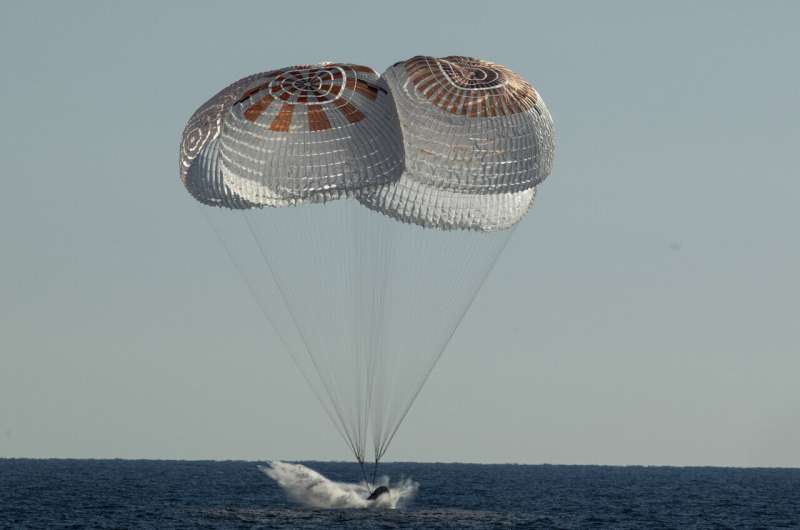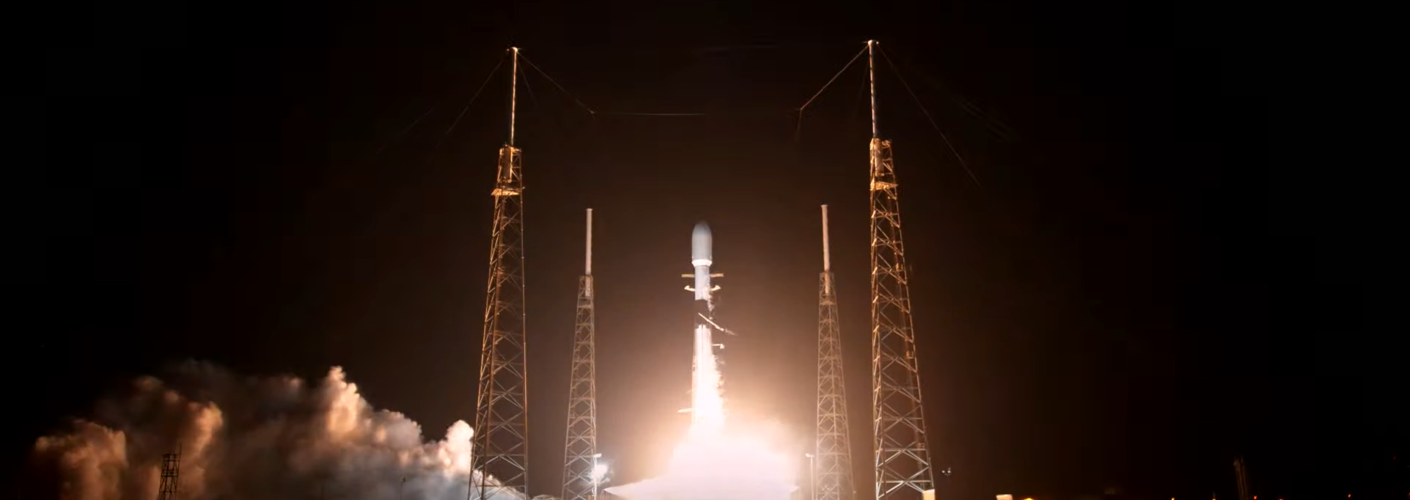Eagle-designed space drones target in-orbit construction
Sunday, 16 October 2022 10:52 What if vehicles could be assembled in space without human supervision? What if autonomous spacecraft could conduct routine maintenance and inspections on satellites, while flying in orbit around the Earth?
Dr. Hever Moncayo, Embry-Riddle Aeronautical University associate professor of Aerospace Engineering, believes all of this is possible, and he's helping push the technology that will ac
What if vehicles could be assembled in space without human supervision? What if autonomous spacecraft could conduct routine maintenance and inspections on satellites, while flying in orbit around the Earth?
Dr. Hever Moncayo, Embry-Riddle Aeronautical University associate professor of Aerospace Engineering, believes all of this is possible, and he's helping push the technology that will ac Crew-4 astronauts splash down after 170 days in space
Sunday, 16 October 2022 10:52 The International Space Station Crew-4 returned to Earth on Friday in the Dragon Freedom capsule after almost six months in space, landing off the coast of Florida.
Splashdown occurred at 4:55 p.m. EDT after NASA and Space X mission controllers canceled the attempt Thursday due to weather concerns in the recovery area off Jacksonville.
The descent took about five hours, aided at
The International Space Station Crew-4 returned to Earth on Friday in the Dragon Freedom capsule after almost six months in space, landing off the coast of Florida.
Splashdown occurred at 4:55 p.m. EDT after NASA and Space X mission controllers canceled the attempt Thursday due to weather concerns in the recovery area off Jacksonville.
The descent took about five hours, aided at Musk says cannot fund Starlink in Ukraine indefinitely
Sunday, 16 October 2022 10:52 Elon Musk said Friday that SpaceX would not be able to pay for Starlink satellite internet in Ukraine indefinitely, while the US military confirmed it was communicating with the billionaire's company about funding for the key network.
The discussions come as Musk has been embroiled in public spats with Ukrainian leaders who were angered by his controversial plan for de-escalating the conflic
Elon Musk said Friday that SpaceX would not be able to pay for Starlink satellite internet in Ukraine indefinitely, while the US military confirmed it was communicating with the billionaire's company about funding for the key network.
The discussions come as Musk has been embroiled in public spats with Ukrainian leaders who were angered by his controversial plan for de-escalating the conflic NASA Crew-4 astronauts safely splash down in Atlantic
Sunday, 16 October 2022 10:52 NASA's SpaceX Crew-4 astronauts aboard the Dragon spacecraft safely splashed down Friday off the coast of Jacksonville, Florida, completing the agency's fourth commercial crew mission to the International Space Station. The international crew of four spent 170 days in orbit.
NASA astronauts Bob Hines, Kjell Lindgren, and Jessica Watkins and ESA (European Space Agency) astronaut Samantha Cr
NASA's SpaceX Crew-4 astronauts aboard the Dragon spacecraft safely splashed down Friday off the coast of Jacksonville, Florida, completing the agency's fourth commercial crew mission to the International Space Station. The international crew of four spent 170 days in orbit.
NASA astronauts Bob Hines, Kjell Lindgren, and Jessica Watkins and ESA (European Space Agency) astronaut Samantha Cr Asteroid sample return mission on track for Fall '23 Delivery
Sunday, 16 October 2022 10:52 NASA's first asteroid sample return spacecraft, OSIRIS-REx, fired its thrusters for 30 seconds on Sept. 21 and nudged its trajectory toward Earth. The resulting course correction keeps the vehicle on track to deliver a sample of asteroid Bennu to Earth on Sept. 24, 2023, completing a seven-year mission.
The delivery itself, however, is not a simple parcel drop on Earth's front doorstep: NA
NASA's first asteroid sample return spacecraft, OSIRIS-REx, fired its thrusters for 30 seconds on Sept. 21 and nudged its trajectory toward Earth. The resulting course correction keeps the vehicle on track to deliver a sample of asteroid Bennu to Earth on Sept. 24, 2023, completing a seven-year mission.
The delivery itself, however, is not a simple parcel drop on Earth's front doorstep: NA Things that go bump in the night on Mars!
Sunday, 16 October 2022 10:52 You stand in Jezero crater, Mars, at a minute to midnight. By the light of the stars and Mars's two tiny moons, Phobos and Deimos, you can just make out the shape of the looming delta. Nothing moves; the wind tonight is too low to even push a sand grain over. All is peaceful and quiet. Then, out of nowhere, comes an alien, mechanical whirring noise... and a misshapen head rises up out of the dar
You stand in Jezero crater, Mars, at a minute to midnight. By the light of the stars and Mars's two tiny moons, Phobos and Deimos, you can just make out the shape of the looming delta. Nothing moves; the wind tonight is too low to even push a sand grain over. All is peaceful and quiet. Then, out of nowhere, comes an alien, mechanical whirring noise... and a misshapen head rises up out of the dar NASA studies origins of dwarf planet Haumea
Sunday, 16 October 2022 10:52 Using computer simulations, scientists based at NASA have pieced together the story of how the dwarf planet Haumea, found in the Kuiper Belt of icy worlds beyond the orbit of outermost planet Neptune, became one of the most unusual objects in the solar system.
Nearly the size of Pluto, Haumea is strange in several ways. It spins faster, by far, than anything else of its size, whirling on i
Using computer simulations, scientists based at NASA have pieced together the story of how the dwarf planet Haumea, found in the Kuiper Belt of icy worlds beyond the orbit of outermost planet Neptune, became one of the most unusual objects in the solar system.
Nearly the size of Pluto, Haumea is strange in several ways. It spins faster, by far, than anything else of its size, whirling on i Heaviest element yet detected in an exoplanet atmosphere
Sunday, 16 October 2022 10:52 Using the European Southern Observatory's Very Large Telescope (ESO's VLT), astronomers have discovered the heaviest element ever found in an exoplanet atmosphere - barium. They were surprised to discover barium at high altitudes in the atmospheres of the ultra-hot gas giants WASP-76 b and WASP-121 b - two exoplanets, planets which orbit stars outside our Solar System. This unexpected discovery
Using the European Southern Observatory's Very Large Telescope (ESO's VLT), astronomers have discovered the heaviest element ever found in an exoplanet atmosphere - barium. They were surprised to discover barium at high altitudes in the atmospheres of the ultra-hot gas giants WASP-76 b and WASP-121 b - two exoplanets, planets which orbit stars outside our Solar System. This unexpected discovery Blue Skies Space satellite will monitor how energy released by stars impacts exoplanet habitability
Sunday, 16 October 2022 10:52 Stars, including our own Sun, can release huge amounts of energy during outbursts called flares. The most intense ones pose a danger to modern society through disruption to electricity grids, satellite systems and the Earth's climate. Blue Skies Space's new satellite Mauve is designed to monitor the flaring activity of stars that are hosts to potentially habitable exoplanets (planets outside our
Stars, including our own Sun, can release huge amounts of energy during outbursts called flares. The most intense ones pose a danger to modern society through disruption to electricity grids, satellite systems and the Earth's climate. Blue Skies Space's new satellite Mauve is designed to monitor the flaring activity of stars that are hosts to potentially habitable exoplanets (planets outside our NASA's Swift, Fermi missions detect exceptional cosmic blast
Sunday, 16 October 2022 10:52 Astronomers around the world are captivated by an unusually bright and long-lasting pulse of high-energy radiation that swept over Earth Sunday, Oct. 9. The emission came from a gamma-ray burst (GRB) - the most powerful class of explosions in the universe - that ranks among the most luminous events known.
On Sunday morning Eastern time, a wave of X-rays and gamma rays passed through the so
Astronomers around the world are captivated by an unusually bright and long-lasting pulse of high-energy radiation that swept over Earth Sunday, Oct. 9. The emission came from a gamma-ray burst (GRB) - the most powerful class of explosions in the universe - that ranks among the most luminous events known.
On Sunday morning Eastern time, a wave of X-rays and gamma rays passed through the so Arecibo Observatory in Puerto Rico will not be rebuilt
Sunday, 16 October 2022 10:52 The National Science Foundation said Friday that it won't rebuild the Arecibo Observatory in Puerto Rico, and instead pans to build a STEM-focused education center.
The center would expand upon existing education and outreach opportunities, and is expected to open in 2023, the NSF said in a statement.
The NSF is soliciting proposals to manage "the education, STEM research, and ou
The National Science Foundation said Friday that it won't rebuild the Arecibo Observatory in Puerto Rico, and instead pans to build a STEM-focused education center.
The center would expand upon existing education and outreach opportunities, and is expected to open in 2023, the NSF said in a statement.
The NSF is soliciting proposals to manage "the education, STEM research, and ou SpaceX ferries astronauts back to Earth after half-year away
Saturday, 15 October 2022 17:17
Four astronauts returned to Earth in a SpaceX capsule Friday, ending their nearly six-month space station mission with a splashdown in the Atlantic off Florida.
Wet and windy weather across Florida delayed their homecoming. SpaceX and NASA finally gave the all-clear on Friday, and the three Americans and one Italian departed the International Space Station, their residence since April.
The capsule parachuted into the ocean, just off Jacksonville, Florida, about five hours later.
DoD eyeing options to provide satcom in Ukraine as it continues talks with SpaceX
Saturday, 15 October 2022 16:01
The Pentagon is looking at options to provide satellite communications services for Ukraine’s military forces following Elon Musk’s warning that SpaceX will suspend Starlink internet services in Ukraine unless the U.S.
NASA's Lucy to fly past thousands of objects for Earth gravity assist
Saturday, 15 October 2022 09:07
Mission engineers will track NASA's Lucy spacecraft nonstop as it prepares to swoop near Earth on Oct. 16 to use this planet's gravity to set itself on a course toward the Jupiter Trojan asteroids.
But they also will be closely tracking something else: more than 47,000 satellites, debris, and other objects circling our planet. A greater than 1-10,000 chance that Lucy will collide with one of these objects will require mission engineers to slightly adjust the spacecraft's trajectory.
Although an adjustment is unlikely, and collisions are rare, the chances are increasing as the number of objects in Earth's orbit grows, NASA experts say.
The International Space Station, for instance, has maneuvered out of the way of space debris 31 times since 1999, including three times since 2020.
"Low-Earth orbit is getting more crowded, so that has to be part of the consideration nowadays, especially for missions that fly low, like Lucy," said Dr.
First Eurostar Neo satellite launched
Saturday, 15 October 2022 05:37
The first satellite to be built under ESA’s Eurostar Neo programme has launched.

